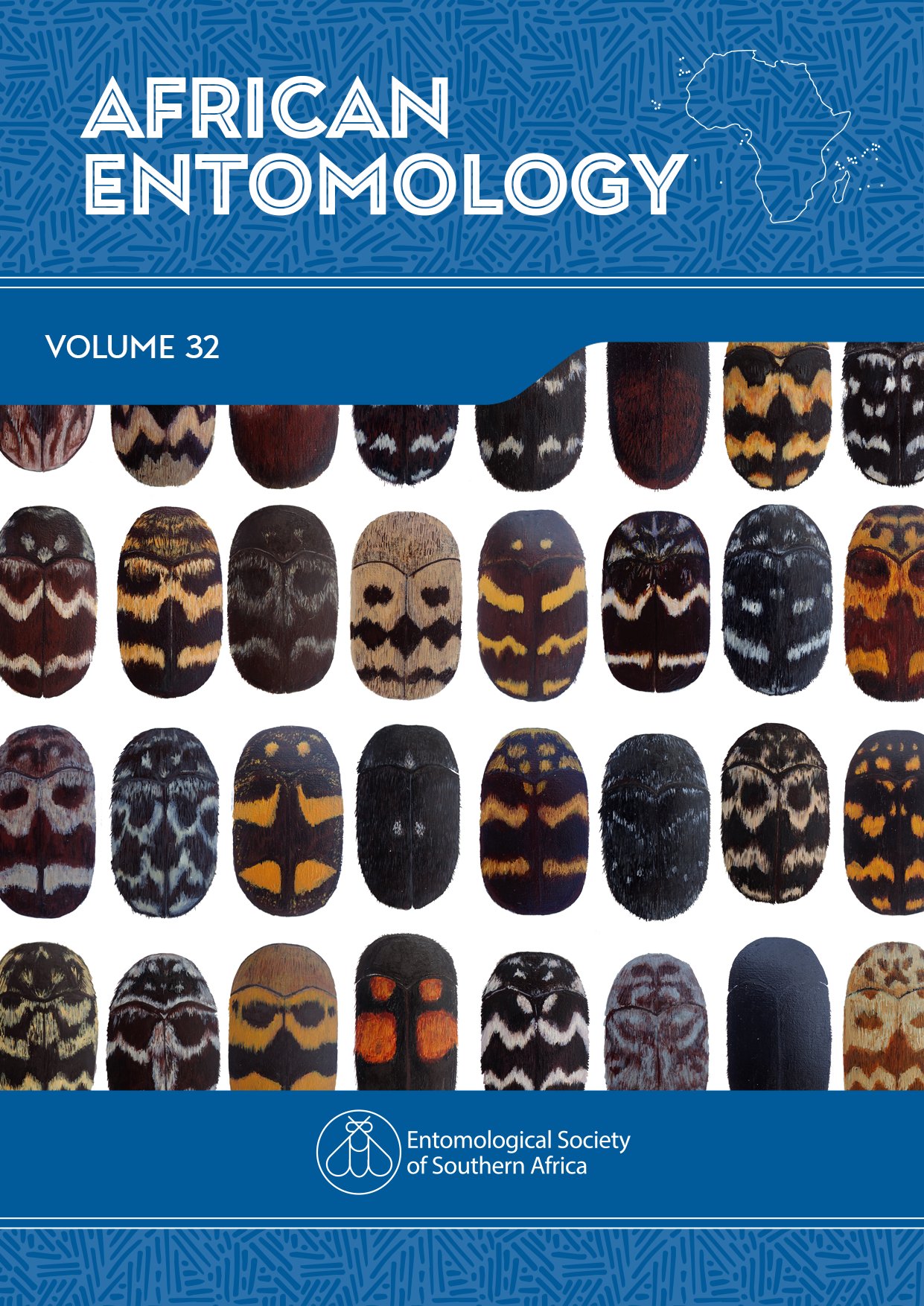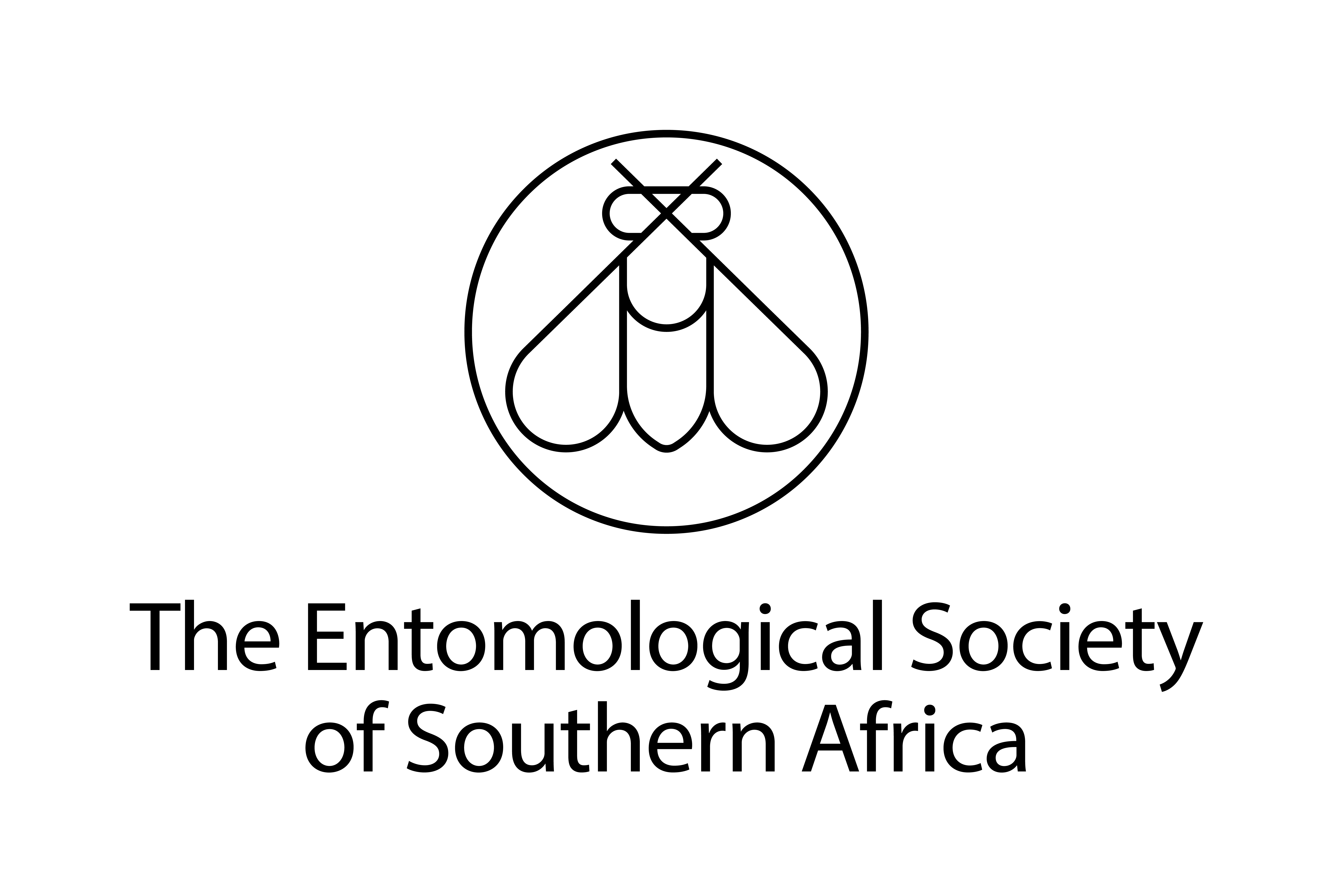New data on an old pest complex: The status of Phlyctinus callosus Schönherr and Phlyctinus xerophilus Haran (Coleoptera: Curculionidae) in South Africa
DOI:
https://doi.org/10.17159/2254-8854/2024/a17422Keywords:
Cryptic species complex, deciduous fruit, grapevine, phytosanitary, taxonomical revision, Western Cape ProvinceAbstract
Phlyctinus is an endemic weevil genus of the Cape Floristic Region that comprises eight to ten species, previously classified under the monotypic P. callosus sensu lato concept. Two species of this genus, Phlyctinus callosus and P. xerophilus, are of economic concern to the deciduous fruit and grapevine industry in the Western Cape province of South Africa, causing primary damages and being of phytosanitary concern at the adult stage. The taxonomic revision conducted in 2020 raised doubts whether one of the two species was a newly emerging pest and/or what species was considered in studies before the clarification of species boundaries. Also unclear is whether these species can be controlled similarly using current control measures. The aim of this study therefore is to review the pest status of the two species over time based on museum records, field collections and historical publications, and to clarify how control measure(s) are impacted. We infer that neither species appear to be emerging pests in the region, both being of agricultural significance for at least 80 years. Phlyctinus callosus is mostly distributed along the southern coast, while P. xerophilus is distributed in inland valleys. The two species show similar biology, physiology and ecology in agro-ecosystems, and can be excluded from the host plant canopy using stem-barriers, adults being flightless. As such, it is shown that the naming of P. xerophilus as a pest is mainly a taxonomical clarification within a pre-existing species complex.
Downloads
References
Annecke DP, Moran VC. 1982. Insects and mites of cultivated plants in South Africa. Durban: Butterworths.
Barnes BN, Giliomee JH. 1992. Fruit-feeding behaviour of banded fruit weevil, Phlyctinus callosus (Schönherr) (Col., Curculionidae), in apple orchards. Journal of Applied Entomology. 113(1-5):407–415. https://doi.org/10.1111/j.1439-0418.1992.tb00681.x
Barnes BN, Knipe MC, Calitz FJ. 1994. Trunk barriers provide effective control of banded fruit weevil on apples and nectarines. Deciduous Fruit Grower. 44:327–340.
Barnes BN, Knipe MC, Calitz FJ. 1995. Effective weevil control on apple trees with batting trunk barriers. Deciduous Fruit Grower. 45:376–378
Barnes BN, Knipe MC, Calitz FJ. 1996. Latest results with trunk exclusion barriers for weevil control on apples (Jongste resultate met stamsperbande vir kalander beheer op appels). Deciduous Fruit Grower. 46:284–287.
Bortolus A. 2008. Error cascades in the biological sciences: the unwanted consequences of using bad taxonomy in ecology. Ambio. 37(2):114–118. https://doi.org/10.1579/0044-7447(2008)37[114:ECITBS]2.0.CO;2.
Bragard C, di Serio F, Gonthier P, Miret JAJM, Justesen AF, Magnusson S, Milonas P, Navas-Cortes JA, Parnell S, Potting R, et al. 2021. Pest categorization of Phlyctinus callosus. EFSA Journal. 19(8):6800. https://doi.org/10.2903/j.efsa.2021.6800
Bredenhand E, Van Hoorn A, May F, Ferreira T, Johnson S. 2010. Evaluation of techniques for monitoring banded fruit weevil, Phlyctinus callosus (Schöenherr) (Coleoptera: Curculionidae), infestation in blueberry. African Entomology. 18(1):205–209.
https://doi.org/10.4001/003.018.0118
Hansen SP. 2023. Phlyctinus callosus (Coleoptera: Curculionidae) species complex linked to biological control and ecology. Doctoral thesis. Stellenbosch University, South Africa.
Hansen SP, Malan AP, Haran JM, Addison P. 2023. Susceptibility of adult Phlyctinus (Coleoptera: Curculionidae) to entomopathogens: A first look at potential differences in a newly revised species complex. Journal of Applied Entomology. jen.13214.
https://doi.org/10.1111/jen.13214
Hansen SP, Malan AP, Haran JM, Dunn MD, Addison P. 2024. Steinernema yirgalemense (Steinernematidae) to control Phlyctinus callosus and Phlyctinus xerophilus (Curculionidae). Nematology. 9:1–16. https://doi.org/10.1163/15685411-bja10305
Haran J, Hansen S, Benoit L, Addison P. 2020. Description of five new species in the genus Phlyctinus Schoenherr (Coleoptera, Curculionidae): a first step in deciphering the P. callosus complex. European Journal of Taxonomy. 669(669):1–29. https://doi.org/10.5852/ejt.2020.669
Hévin NM-C, Hansen S, Addison P, Benoit L, Kergoat GJ, Haran J. 2022. Late Cenozoic environmental changes drove the diversification of a weevil genus endemic to the Cape Floristic Region. Zoologica Scripta. 51(6):724–741. https://doi.org/10.1111/zsc.12563
Johnson SA, Neven LG. 2011. Heat-controlled atmosphere postharvest treatments for Macchiademus diploterus (Hemiptera: Lygaeidae) and Phlyctinus callosus (Coleoptera:Curculionidae). Journal of Economic Entomology 104(2):398–404. https://doi.org/10.1603/EC10316
Laborieux L. 2023. Host plant shifts and the emergence of new pest insects: the case of the weevil genus Phlyctinus. MSc thesis. University of Montpellier, France.
Lounsbury CP. 1896. The calandra (Phlyctinus callosus, Bohem). Agricultural Journal of the Cape of Good Hope. 9:63–64.
Marais E, Barnes BN. 2004. Weevils on apples and pears. Stellenbosch: ARC Infruitec-Nietvoorbij. p 7599.
Marvaldi AE, Lanteri AA, del Río MG, Oberprieler RG. 2014. 3.7.5. Entiminae Schoenherr, 1823. In: Leschen RA, Beutel RG (editors), Handbook of Zoology. Coleoptera, beetles-morphology and systematics. 3. Berlin: De Gruyter. p. 503–522.
PPIS. 2006. Bilateral quarantine agreement between the plant protection and inspection services of Israel (PPIS) and the National Department of Agriculture Directorate: Plant Health and Quality of the Republic of South Africa (DPHQ) regarding the conditions for the importation of fresh grapes (Vitis vinifera) from the Republic of South Africa into Israel. State of Israel, Ministry of Agriculture and Rural Development, Plant Protection and Inspection Services, Bet-Dagan, Israel.
Pringle KL, Barnes BN, Blomefield TL. 2015. Apple. In: Prinsloo GL, Uys VM (editors), Insects of Cultivated Plants and Natural Pastures in Southern Africa. Hatfield: The Entomological Society of Southern Africa. p. 350–365.
Prinsloo GL, Uys VM. 2015. Insects of cultivated plants and natural pastures in Southern Africa. Hatfield: The Entomological Society of Southern Africa.
Pryke JS, Samways MJ. 2007. Current control of phytosanitary insect pests in table grape vineyards of the Hex River Valley, South Africa. African Entomology. 15(1):25–36.
https://doi.org/10.4001/1021-3589-15.1.25
Schwartz A. 1988. Efficacy of trunk barriers for the control of key pests on trellised grapevines. South African Journal for Enology and Viticulture. 9(1):16–18. https://doi.org/10.21548/9-1-2304
Smit R, Jooste MM, Johnson, SA. 2018. CATTS technology: Phytosanitary control and market expansion of chill sensitive Japanese plums for South Africa. Acta Horticulturae. (1194):201–208. https://doi.org/10.17660/ActaHortic.2018.1194.30
Smit R, Jooste MM, Addison MF, Johnson SA. (2020). Ethyl formate fumigation: Its effect on stone and pome fruit quality, and grain chinch bug (Macchiademus diploterus) mortality. Scientia Horticulturae. 261:108845. https://doi.org/10.1016/j.scienta.2019.108845
USDA-APHIS. 2007. Work plan for the USDA preclearance inspection and cold treatment of South African deciduous fruit designated for export to the United States of America. USA. South African Department of Agriculture, Land Reform and Rural Development.
Whitehead VB. 1961. Vine snoutbeetles: Some facts about them and their control. Deciduous Fruit Grower. 11(9):261–263.
Downloads
Additional Files
Published
Issue
Section
License
Copyright (c) 2024 Steffan Hansen, Julien M. Haran, Shelley A. Johnson, Noémie M.-C. Hévin, Pia Addison

This work is licensed under a Creative Commons Attribution 4.0 International License.
How to Cite
Funding data
-
Hortgro Science
Grant numbers NP6-2021 -
National Research Foundation
Grant numbers 132353




.png)